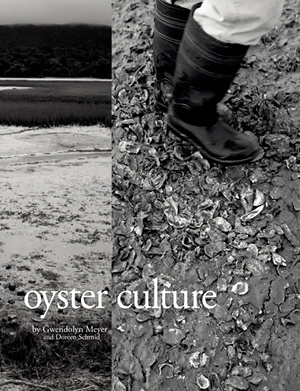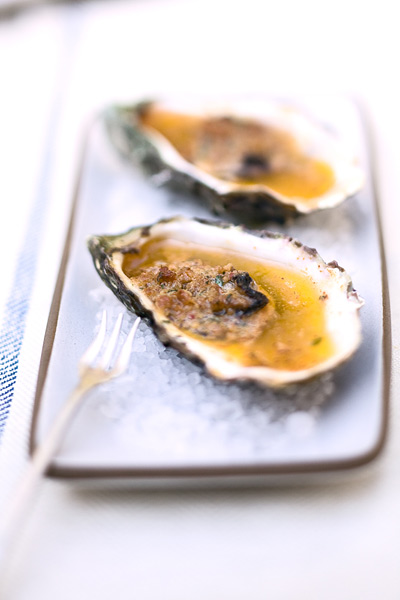 What's on your locavore's barbecue this Labor Day weekend? A slab of beef tri-tip, our favorite regional cut, sliced and nestled up to a stack of red torpedo onions and dry-farmed Early Girl tomatoes sounds mighty tasty. If you prefer fish, try a side of grilled sockeye or king salmon topped with this easy corn relish. And to start, what captures the taste of our unique coastal landscape than a a platter of oysters plucked from the salt-sweet estuaries of Tomales Bay or Point Reyes?
What's on your locavore's barbecue this Labor Day weekend? A slab of beef tri-tip, our favorite regional cut, sliced and nestled up to a stack of red torpedo onions and dry-farmed Early Girl tomatoes sounds mighty tasty. If you prefer fish, try a side of grilled sockeye or king salmon topped with this easy corn relish. And to start, what captures the taste of our unique coastal landscape than a a platter of oysters plucked from the salt-sweet estuaries of Tomales Bay or Point Reyes?
You can shuck and serve them raw, with nothing more than a squirt of lemon and a shake of hot sauce, or get a little more fancy with a saucer of mignonette sauce. Mignonette may sound lah-di-dah, but it's nothing more than a tart dunk of minced shallot, black pepper, and champagne vinegar. At its popular restaurant and oyster bar in the Ferry Building, the Hog Island Oyster Company has California-ized this French classic into a "Hog Wash" of shallot, minced jalapeno, cilantro, and both seasoned and plain rice vinegar. Or you can raise a toast to a particularly local tradition and barbecue them right on the grill. No shucking required; just place oysters, flat side up, on a hot grill until the shells pop open. Off the heat, remove the top shell, loosen the oyster within with a quick swipe of an oyster knife, and top with your favorite barbecue sauce. You can return the oysters to the grill for a minute or two to heat the sauce through. Whatever you do, the oysters will be sexy and succulent, with a clean ocean taste like the first fresh slap of a wave against your face.
Once your appetite is whetted, you might want to know more about these intriguing little bivalves, so rich in history and lore. Oyster Culture by Gwendolyn Meyer and Doreen Schmid, is a great place to start. Illustrated with Meyer's beautiful, evocative black-and-white and color photographs as well as historical documents and pictures, the book, published by Petaluma's Cameron Press, delves into the history and ecology of the local oyster industry. How did the book happen? Via email, Meyer told us,
"The book evolved from a photo essay on how oysters are farmed on one farm into the bigger story of oyster farming out here in West Marin. I started shooting grainy black and white film images back in 2001 out on the water and the gritty grainy look captured the hard working farmers on the bay on its foggy overcast cold windy days. The Tomales Bay is a special and unique place, one of the few clean estuariane systems left in California. The water-based farms fascinated me, and being out on the bay was captivating. Getting to know some of the people involved with oysters here and the history of the east shore-- I realized that there was a story that hadn't been told.
Photos from Oyster Culture copyright Gwendolyn Meyer
People in California have been eating oysters for centuries. Archaeological digs at Coast Miwok campsites have revealed piles of oyster, mussel, and clam shells. The native oyster of California's indigenous peoples and first settlers was the small, coppery-tasting Olympia oyster, Ostreo lurida. It has since been replaced, first by Atlantic varieties shipped in from the East Coast, then, since the 1930s, by Japanese Pacific varieties like the Miyagi and the Kumamoto. At first, commercial oyster farming was concentrated in San Francisco Bay, but as silt and pollution threatened the beds, the oyster companies looked north, to the more pristine estuaries of Tomales Bay and the Point Reyes peninsula. Oysters thrive in flat tidal estuaries where the river meets the sea, as part of a very particular coastal ecology. Once railways were established, linking the once-remote hamlets of West Marin to San Francisco and the surrounding towns, local aquaculture took off. As Oyster Culture notes, "For a brief moment in the 1950s, Tomales Bay was the largest oyster producer in California. Today, it is the state's smallest production area, but home of its oldest oyster farm and last oyster-canning factory, at Drakes Bay Estero."
